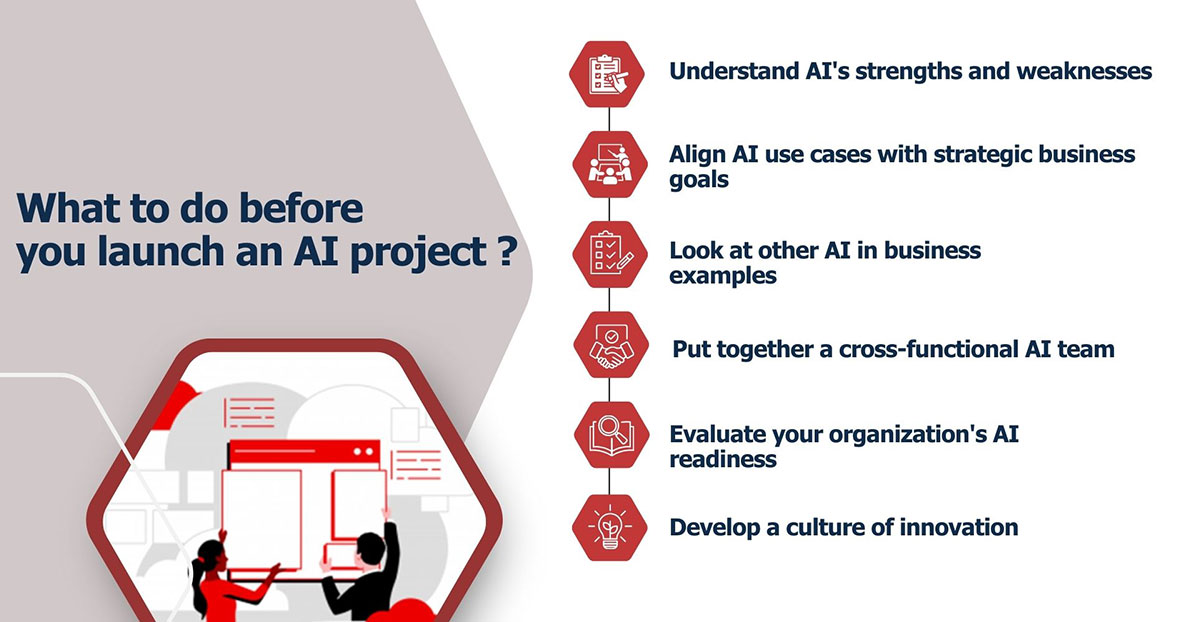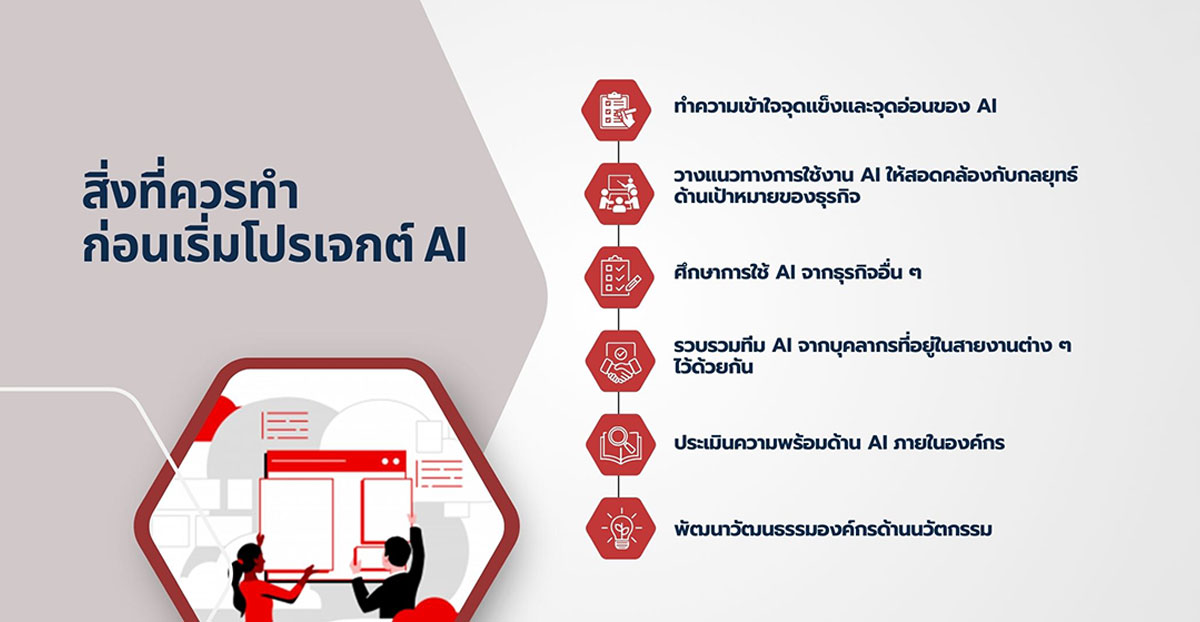Navigating the new normal of constant innovation with AI use cases

Artificial intelligence (AI) has moved from speculative fiction to everyday reality seemingly overnight. Anywhere we look, there are companies promoting their latest AI and machine learning (ML) products or features, ranging from text generators to chatbots to automated podcast editors and everything else under the sun. AI is suddenly everywhere, and it is arguably the most significant technological advancement we’ve seen since the birth of the internet.
But according to some estimates, over 80 percent of AI projects fail, demonstrating a clear disconnect between how people and organizations think about AI and ML and how they’re approaching this new era of innovation.
So, how can we best avoid this fate? How can we reduce the risk of AI project failure in our business
What to do before we launch an AI project
AI projects are similar to other technology projects, and are more likely to be successful if we:
- Understand AI’s strengths and weaknesses
- Align AI use cases with strategic business goals
- Look at other AI in business examples
- Put together a cross-functional AI team
- Evaluate our organization’s AI readiness
- Develop a culture of innovation
Starting with these can help set our AI app development projects up for success. Let’s go over each of these in more detail.
Understand AI’s strengths and weaknesses
Generative AI (gen AI) is incredibly good at sounding like it knows what it’s talking about, but it simply doesn’t. Gen AI applications have no understanding of the content they create. They’re not really “intelligent,” so much as they are very, very advanced autocomplete apps that, based on their training, can recognize and mimic language patterns and word associations.
Since they sound so convincing, it’s very easy to believe that gen AI applications are capable of advanced and complex tasks. This can lead to AI projects that fail because the tasks they are asked to complete are simply more than the AI technology can currently handle.
So, before we embark on our first gen AI app development project, it’s important to understand the strengths and weaknesses of current gen AI technology.
Gen AI strengths and weaknesses
Some of the things gen AI excels at include:
- Processing vast quantities of data
- Analyzing that data
- Reformatting text
- Automating simple, repetitive tasks
- Retrieving and summarizing information
- Matching and identifying patterns
- Classifying information
- Acting as a brainstorming aid
As for weaknesses, gen AI:
- Is incapable of actual thinking or reasoning
- Is unable to recognize or understand context without specific prompting
- Cannot execute complex actions
- Doesn’t know what it doesn’t know, so tends to generate hallucinations or misinformation
- Is incapable of producing original work
- Lacks any form of creativity or creative thinking
- Doesn’t have any concept of ethics or empathy
Current gen AI applications are similar to automation tools in that they are best suited to handling mundane and repetitive tasks at scale, freeing up people and teams to spend their time and energy on more complex, creative and innovative work.
Align AI use cases with strategic goals
In spite of the hype, AI isn’t going to solve all of our problems and is still very limited in what it can actually do. We’re going to have to bring possible applications for AI down to a practical level and spend some time looking at how AI can realistically fit into our existing business strategies.
In the end, the AI applications we develop aren’t what our customers are going to see or be talking about—the AI will be hidden behind the scenes as largely invisible components of our applications, services and processes.
What our customers will see are applications that are smarter, services that are easier to use, and processes that are more efficient. The AI components allow we to infuse our organization’s data, knowledge and expertise into our products and services to give our customers a better and more consistent experience across the board.
When we’re just getting started, consider prioritizing AI use cases that will deliver value in the near term, such as improving teams’ productivity, or optimizing support services and personalization for existing or returning customers. Avoid use cases that are central to core business until we are comfortable with AI and the data we are feeding into it.
Look at other AI in business examples
Organizations across a vast array of industries are successfully using AI in innovative and impactful ways that may serve as inspiration for our AI use cases and experiments. Many of these are helping improve efficiency, providing better customer experiences and facilitating better and faster decision-making, among other things.
Some recent examples include:
- Retailers are using AI to generate personalized recommendations for returning customers, improve and optimize their supply chains.
- IT support organizations are using AI to help categorize support tickets and identify and (automatically!) resolve recurring issues.
- Software developers are using AI-powered coding assistants to be more efficient, reducing rote work so they can spend more time focusing on higher-value tasks.
- Manufacturers have started using AI to help predict equipment failures and optimize production schedules.
- Financial institutions are using AI to detect fraudulent transactions and predict stock market trends.
- Healthcare organizations are using AI to help design new drug molecules, create personalized health reports and improve diagnostic processes.
- E-commerce sites and online marketplaces are using gen AI to power customer support and sales chatbots.
As we read about and research other examples of AI use cases, we’ll run across some that are (often significantly) more advanced than others, but we’ll eventually develop a sense of what’s possible with current gen AI technologies.
Build a cross-functional AI team
Like most tech projects, AI projects will require expertise from across the breadth of our organization, including:
- Data science and analytics
- IT/engineering
- Application development
- Data management
- Business strategy
- User research
- Marketing and communications
- Legal/Compliance
- Other domain experts as needed
By bringing interested participants together from these different disciplines, our team will be armed with an array of perspectives, experience and opinions. This Center of Excellence will help make sure that potential AI use cases are both technically feasible and remain aligned with our organization’s strategic goals.
Cross-functional teams also encourage collaboration between people and teams that might not normally interact regularly, better promoting the free flow of ideas, insights and expertise.
Evaluate our organization’s AI readiness
There’s little point in devising potential gen AI app development projects if our organization is lacking in terms of talent, data or infrastructure.
Your new cross-functional AI team will be able to help we determine our current ability to incorporate AI into our products, as many will have clearer or deeper insights into their specific organization’s strengths and weaknesses.
If there are clear weaknesses identified, this will help we prioritize investments in infrastructure, data development and training.
Develop a culture of innovation
The era of AI is really just in its earliest stages, and our first few experiments and use cases will be just the beginning. Developing a culture of innovation in our organization will help us prepare for the disruptive potential AI will bring in both the short- and long-term.
There is no shortage of advice about how to shift our organizational culture to be more innovative, though here are three ways to get started:
1) Cultivate a spirit of experimentation
Innovation requires experimentation, and constant innovation requires constant experimentation. While it’s a certainty that the vast majority of innovation experiments will fail, those occasional successes can make it all worthwhile. And the more successes we rack up, the more innovative our organization will become. Over the long term, continually running a large number of experiments (ideally that build on each other over time) can potentially net we a significant competitive advantage.
While shifting culture can be slow and complicated, there are some fairly straightforward ways to encourage more experimentation in our organization:
- Set clear goals and objectives: Be clear and concrete about what we want to achieve, and attach metrics wherever possible. For example, “Increase article conversion rate by 15% over the next 6 months” will give a team something specific to focus on. Objectives should be achievable but challenging.
- Cultivate curiosity: Encourage people to continually think about how things could be better, simpler, easier or more efficient. And give them the time and space to explore new ideas when they emerge.
- Embrace failure: As the saying goes, “Fail fast, learn faster.” And celebrate failures—we learn something even through failed experiments and each brings we one step closer to an innovation breakthrough.
- Measure everything: There’s no experimentation without measurement. If we have no clearly established metrics in place, there’s little point in running an experiment. Measure everything and gather as much data as possible. Another saying applies here, “You can’t change what we don’t measure.”
- Establish a data-first mindset: Having data is one thing, but it’s only useful if we actually look at it. Consider having regular meetings to go over our data, to discuss what it means, to explore interesting insights, and to encourage connections and inspiration. Also, if an experiment is sound and the data is good, the experiment results should overrule any individual opinions on a matter. This isn’t always possible, of course, but data should normally rule the day.
- Lead by example: Reward (reasonable) risk taking. Celebrate failures as learning opportunities. Encourage curiosity. And, of course, always reward and celebrate the successes.
2) Foster a culture of continuous learning
Establishing a culture of continuous learning will help increase the level and scope of innovation in our organization. A spirit of experimentation is also more likely to thrive when people and teams are motivated to be open-minded, self-driven learners.
Continuous learning opportunities can come in a wide variety of shapes and sizes, including:
- Regular, peer-led masterclasses
- Paid access to microlearning platforms
- Peer coaching and “lunch and learn” sessions
- Workshops or lectures led by external experts
3) Invest in talent development
More formal investment in talent development will also help develop a culture of innovation in our organizations. Where possible, enable teams to:
- Take courses in emerging technologies
- Attend workshops, webinars and conferences
- Engage in training programs
- Participate in formal mentoring programs
- Take advantage of other upskilling opportunities
This sort of in-house talent investment will help our people advance their careers, stay motivated and engaged and explore new interests, all towards increasing their contributions within our organization as a whole.
With this, you should be pretty well situated for embarking on your first AI app development project.






